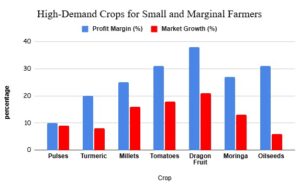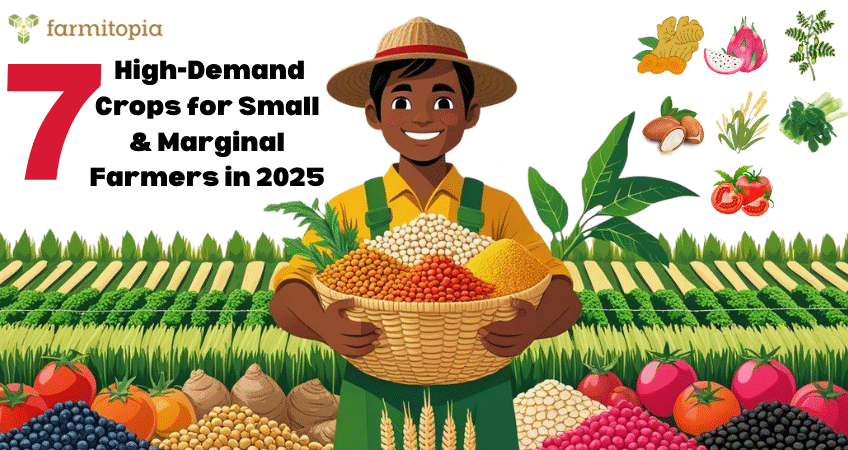Boost Income with Nutritional & Residue-Free Produce
Change is the only constant, combined now with the extreme rapidity in pace of change… We are living in interesting times! Well thought through quick crop portfolio adjustments can go a long way in adapting to the changes, ever so important for small and marginal farmers.
In 2025, consumers aren’t just buying food- they’re investing in health, sustainability, and traceability. According to a FAO report (2024), demand for nutrient–rich, residue–free crops is expected to grow by 18% annually in Asia. For small farmers, this shift presents a once-in-a-decade opportunity to tap into premium markets and significantly boost income.
If you’re a small farmer wondering “Which crops will sell best and fetch premium prices this year?”– this guide can be one of your blueprint, backed by scientific data, market trends, and real farmer success stories.
How about considering SCAMPER Analysis for Crop Opportunities
● Substitute: Replace high-input crops with low-water crops (millets, pulses).
● Combine: Intercrop turmeric with pulses to diversify income.
● Adapt: Use hydroponics for tomatoes to increase urban market appeal.
● Modify: Grow residue-free versions of regular crops to target premium markets.
● Put to Another Use: Sell moringa leaves for both fresh and powder markets.
● Eliminate: Reduce pesticide use to enter export markets.
● Reverse: Shift from bulk commodity selling to direct farm-to-consumer models.
Choosing the right crops in 2025 isn’t just about what grows best- it’s about what sells best and sustains your soil, your income, and your future. These seven crops, backed by scientific research and real-world success, are game-changers for small farmers.
Here is a selection of 7 High-Demand Crops for Small and Marginal Farmers in 2025.

1. Pulses (Chickpeas, Lentils, Pigeon Pea)
Why in demand: Rich in protein, low environmental footprint, and promoted under UN’s International Year of Pulses campaigns.
Scientific proof: According to ICAR (2024), pulses enrich soil fertility through nitrogen fixation, reducing fertilizer costs by 30%.
Case Study: Cotton – pigeon pea intercropping at a 6:1 row ratio in Telangana increased net returns to ₹43,858/ha with a B:C ratio of 1.95, proving nearly double profitability over monocropped cotton (PJTSAU study).
2. Turmeric
Why in demand: Global market projected to reach $5.3B by 2030 (Allied Market Research), driven by curcumin’s health benefits.
Scientific proof: Curcumin has proven anti-inflammatory properties (NIH, 2023). Organic turmeric fetches 25–40% higher prices.
Case Study: The overall turmeric supplements market also saw an increase from $25.6 million in 2013 to $151.7 million in 2021, reflecting growing demand – which often translates into price premiums for organic and branded products
3. Millets (Foxtail, Finger, Pearl)
Why in demand: Declared International Year of Millets 2023 by the UN; trend continues due to high fiber, gluten-free diets.
Scientific proof: Millets require 70% less water than rice (ICRISAT, 2023) and thrive in semi-arid zones.
Case Study: In Raichur, Foxtail millet intercropped with redgram boosted yields by 30–45% and doubled farmers’ profits under rainfed conditions (ICAR–UAS, 2018–2020).
4. Tomatoes
Why in demand: Rising processed food and fresh vegetable consumption in urban areas.
Scientific proof: Hydroponic tomatoes produce 30% higher yields with 90% less water (FAO, 2023).
Case Study: In Maharashtra, a hydroponic tomato project was supported and sold at 2.5x market price to a Bengaluru organic chain.
5. Dragon Fruit
Why in demand: High export potential, superfood status, and low maintenance after establishment.
Scientific proof: Dragon fruit contains antioxidants and is drought-tolerant, ideal for climate resilience (ICAR-NRCP, 2024).
Case Study: Gujarat farmer Ramesh Patel shifted 2 acres to dragon fruit and earned ₹8 lakh/year, up from ₹2.5 lakh with cotton.
6. Moringa (Drumstick)
Why in demand: Marketed as a superfood; used in supplements, tea, and fortified foods.
Scientific proof: Leaves have 7x more vitamin C than oranges and 4x more calcium than milk (FAO, 2024).
Case Study: Andhra Pradesh moringa growers supplying leaf powder to nutraceutical firms saw 55% higher profit margins.
7. Oilseeds (Soybean, Groundnut, Sunflower)
Why in demand: Edible oils market expected to grow 5% annually; rising demand for cold-pressed oils.
Scientific proof: Crop diversification with oilseeds improves soil health and reduces pest cycles (ICAR, 2023).
Case Study: Gujarat farmers in Farmitopia’s traceability network got 18% premium on cold-pressed sunflower oil seeds.
Ready to grow high-demand, profitable crops with expert guidance?
Join Farmitopia today for crop planning tools, traceability solutions, and market linkages that turn farming into a future-proof business.
📞 Call us now: +91-9449740838

